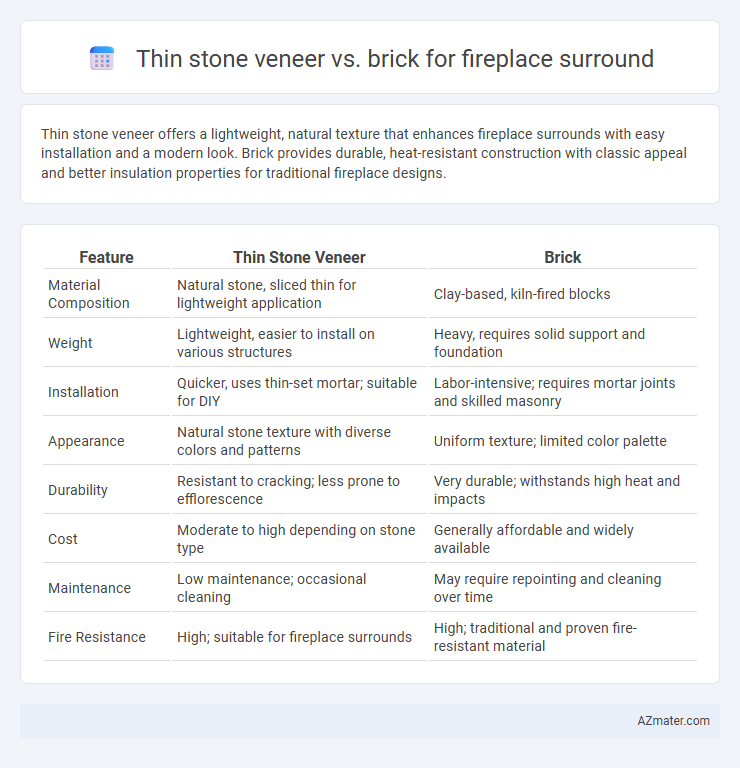Thin stone veneer offers a lightweight, natural texture that enhances fireplace surrounds with easy installation and a modern look. Brick provides durable, heat-resistant construction with classic appeal and better insulation properties for traditional fireplace designs.
Table of Comparison
| Feature | Thin Stone Veneer | Brick |
|---|---|---|
| Material Composition | Natural stone, sliced thin for lightweight application | Clay-based, kiln-fired blocks |
| Weight | Lightweight, easier to install on various structures | Heavy, requires solid support and foundation |
| Installation | Quicker, uses thin-set mortar; suitable for DIY | Labor-intensive; requires mortar joints and skilled masonry |
| Appearance | Natural stone texture with diverse colors and patterns | Uniform texture; limited color palette |
| Durability | Resistant to cracking; less prone to efflorescence | Very durable; withstands high heat and impacts |
| Cost | Moderate to high depending on stone type | Generally affordable and widely available |
| Maintenance | Low maintenance; occasional cleaning | May require repointing and cleaning over time |
| Fire Resistance | High; suitable for fireplace surrounds | High; traditional and proven fire-resistant material |
Introduction to Fireplace Surround Materials
Thin stone veneer offers a lightweight, cost-effective alternative to traditional brick for fireplace surrounds, providing natural stone aesthetics without the heavy structural demands. Brick remains a classic choice, valued for its durability, heat resistance, and timeless appeal, often enhancing the rustic or traditional fireplace design. Both materials present unique installation considerations, with thin stone veneer allowing for easier application on various substrates, while brick typically requires a more substantial foundation and skilled masonry work.
Overview: Thin Stone Veneer vs Brick
Thin stone veneer offers a lightweight, natural stone appearance with easy installation ideal for fireplace surrounds, while brick provides a traditional, durable option with excellent heat resistance. Stone veneer typically requires less structural support compared to solid brick, making it suitable for renovation projects. Both materials vary in cost and maintenance, with stone veneer generally demanding less upkeep but brick offering timeless aesthetic appeal.
Aesthetic Differences and Design Appeal
Thin stone veneer offers a natural, textured look with varied colors and intricate patterns that create a rustic or modern aesthetic, enhancing the fireplace's visual depth and warmth. Brick provides a classic, timeless appeal with uniform texture and warm tones, often evoking traditional or industrial design styles. Choosing between thin stone veneer and brick for fireplace surrounds depends on the desired ambiance and architectural complement, with stone veneers offering versatile design appeal and brick emphasizing heritage and simplicity.
Installation Process and Complexity
Thin stone veneer offers a lighter weight and easier handling compared to traditional brick, reducing the structural support requirements during fireplace surround installation. It typically involves adhesive or thinset application directly over a suitable substrate, making the installation faster and less labor-intensive than brick, which requires precise mortar joint setup and curing time. Brick installation demands skilled masonry work to ensure proper alignment and durability, often increasing complexity and installation duration compared to the more straightforward process of thin stone veneer.
Durability and Longevity Comparison
Thin stone veneer offers superior resistance to heat and weathering, maintaining its structural integrity and appearance for decades, making it highly durable for fireplace surrounds. Brick provides strong thermal mass and excellent fire resistance, ensuring long-lasting performance with minimal maintenance over time. Both materials withstand high temperatures well, but thin stone veneer tends to resist chipping and cracking better, enhancing its longevity in fireplace applications.
Maintenance Requirements for Each Option
Thin stone veneer offers a low-maintenance solution for fireplace surrounds due to its lightweight composition and resistance to cracking, requiring only occasional cleaning with mild soap and water. Brick, known for its durability and heat resistance, demands more frequent upkeep such as sealing to prevent soot buildup and regular inspection for mortar deterioration. Each material's maintenance needs vary significantly, with thin stone veneer minimizing labor while brick ensures long-term structural integrity through routine care.
Cost Analysis: Thin Stone Veneer vs Brick
Thin stone veneer typically costs between $6 and $12 per square foot, making it a more budget-friendly option compared to traditional brick, which ranges from $8 to $15 per square foot. Installation costs for thin stone veneer are generally lower due to its lightweight nature and easier handling, reducing labor expenses. Brick tends to incur higher total costs because of its weight, requiring more skilled labor and additional structural support for fireplace surrounds.
Weight and Structural Considerations
Thin stone veneer offers a lighter alternative to traditional brick for fireplace surrounds, typically weighing between 8 to 15 pounds per square foot compared to brick's 30 to 40 pounds per square foot. This reduced weight lessens the structural load on walls and foundations, often eliminating the need for additional reinforcement. Selecting thin stone veneer can simplify installation and allow greater flexibility in design without compromising structural integrity.
Energy Efficiency and Heat Resistance
Thin stone veneer offers high heat resistance and excellent thermal mass, allowing it to absorb and radiate heat efficiently, which enhances fireplace energy efficiency. Brick also provides strong heat resistance with durable thermal properties but tends to have a higher thermal mass, leading to slower heat dispersion. Choosing thin stone veneer or brick for a fireplace surround impacts energy performance, with stone veneer often preferred for faster heat transfer and brick favored for sustained heat retention.
Choosing the Right Material for Your Fireplace Surround
Thin stone veneer offers a lightweight and cost-effective option for fireplace surrounds, providing natural texture and color variations that enhance rustic or contemporary designs. Brick fireplace surrounds deliver classic durability and heat resistance, creating timeless appeal with versatile patterns and finishes suitable for traditional or modern homes. Consider factors like heat tolerance, installation complexity, maintenance requirements, and overall aesthetic goals when selecting between thin stone veneer and brick to ensure the ideal fireplace surround material.

Infographic: Thin stone veneer vs Brick for Fireplace surround
 azmater.com
azmater.com